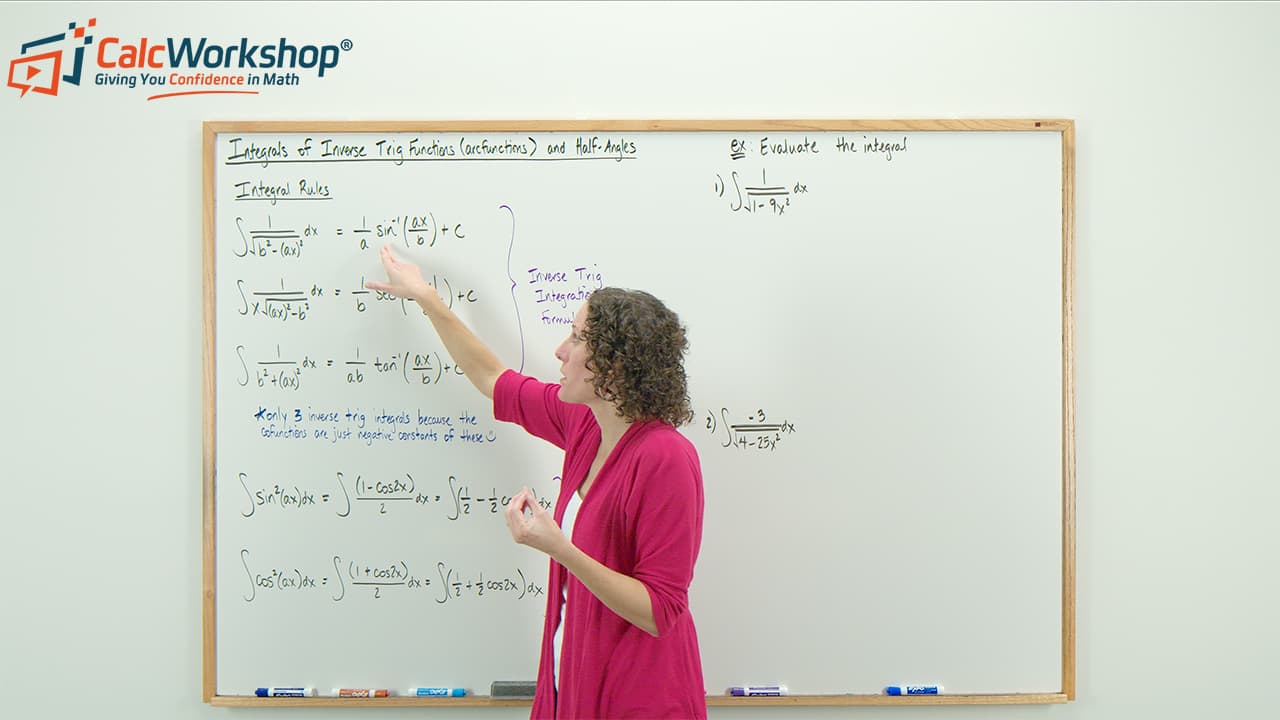Learning about inverse trigonometric functions is like discovering the world of dance partners: there are six unique dancers, but they only perform in pairs. In each duo, one dancer’s moves are the mirror image of the other’s.

Jenn, Founder Calcworkshop®, 15+ Years Experience (Licensed & Certified Teacher)
Why is this important?
Because when it comes to the dance of calculus, there are only three main choreographies involving these inverse trigonometric pairs. That means you only have to learn three dance routines instead of six!
Not only does this save time and effort, but it also reveals an elegant symmetry between the steps of the antiderivative dance and the moves of the derivative dance.
Now, let’s put on our dancing shoes and explore the integral choreographies of inverse trigonometric functions.
Arcsine:
Arcsecant:
Arctangent:
Okay, so the formulas may look intimidating at first, but they really aren’t too scary if you know what to look for.
Notice that all three formulas have a binomial in the denominator, whose terms are both perfect squares. In fact, they are our inverse trig derivatives in disguise!
Which means, if we can spot the pattern, we can integrate pretty quickly.
Let’s look at a few examples to see how to apply these new formulas.
Example 1: Integrate an Arcsin Expression
Evaluate
First, let’s rewrite the integrand to emphasize the perfect squares
Now all we have to do is identify the pieces of the integrand and match them to our formula
Fairly straightforward, right?
Let’s look at two more examples of integration with inverse trig functions
Example 2: Integrate an Arcsec Expression
Evaluate
First, we will rewrite the integrand to emphasize the perfect squares
What do we notice?
Well, this integrand looks like the inverse secant formula!
So, let’s identify the pieces of the integrand and match them to the arcsecant formula
Thus,
Awesome!
Example 3: Integrate an Arctan Expression
Evaluate
Doesn’t think look like a “under cover” inverse tangent?
Let’s rewrite the binomial as perfect squares to check out theory.
Yep! It’s the artangent function all right.
So, now all we have to do is identify the pieces of the integrand and match them to the arctangent formula
Hence,
Cool!
Throughout this lesson we will look at several examples of integrals of inverse trig functions, even ones where the formulas are a bit disguised.
We will also look at two half-angle trigonometric formulas that involve the square of sine and cosine.
Notice that we transform the integrand into a cosine double-angle, and that the formulas are identical except for their signs. For sine-squared, we subtract whereas for cosine-squared we add, and!
Let’s look at an example.
Example 4: Integrate a Sine-Squared Function
Evaluate
First, we rewrite our sine-squared into the cosine double angle identity.
Now we simply integrate each term separately.
Example 5: Integrate a Cosine-Squared Function
First, we rewrite our sine-squared into the cosine double angle identity.
Now we simply integrate each term separately.
Next Steps
In this lesson, you will:
- Work through numerous examples step-by-step
- Master new formulas for integrating inverse trigonometric functions
- Learn how to integrate squares of sine and cosine
Let’s dive in and practice together!
Video Tutorial w/ Full Lesson & Detailed Examples

Get access to all the courses and over 450 HD videos with your subscription
Monthly and Yearly Plans Available
Still wondering if CalcWorkshop is right for you?
Take a Tour and find out how a membership can take the struggle out of learning math.